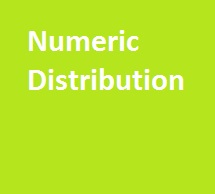ABOUT RETAIL AUDIT


Numeric Distribution measures Product presence in stores. It is defined as percentage of stores that sell(stock*) a certain product, within the Universe of stores (Total Number of stores) in the relevant market:
Numeric Distribution = Number of Stores that sell(stock*) product ÷ Total Number of Stores
*) Stock is relevant for manual Retail Audit only
Example:
| Universe | Distribution of Product X |
|---|---|
| Store #1 | 1 |
| Store #2 | 1 |
| Store #3 | 0 |
| Store #4 | 0 |
| Store #5 | 1 |
Product X is presented in 3 stores out of 5 in the market.
Numeric Distribution = 3÷5 = 60%
This example reflects the case when you can explore the entire set of outlets in the market. However it is not always the case and typically we work with the sample/panel or the mini-model of Universe. In this case the panel results are extrapolated to the Total Universe through projection factors.
Stores of the Panel are grouped according to the outlet type (e.g. small supermarkets, big supermarkets etc). For each group the Projection Factor is calculated as total number of outlets in this group (Universe) divided by number of this type of outlets in the Panel
Example:
| Panel | Type | Number of outlets in Universe | Number of outlets in Panel | Projection Factor |
|---|---|---|---|---|
| Store #1 | Type #1 | 15 | 3 | 5 |
| Store #2 | ||||
| Store #3 | ||||
| Store #4 | Type #2 | 8 | 2 | 4 |
| Store #5 |
Numeric Distribution = (5*1+5*1+5*0+4*0+4*1) ÷ (15+8) = 14÷23 = 60,9%
Use in practice:
Analysis of Numeric Distribution gives an opportunity to understand gaps, improvement opportunities, compare performance with competitors and analyze trends.
When analyzing trends, it is very important to remember that Numeric Distribution is subject to significant seasonal fluctuations. Thus any comparison of one period with another should be done with an adjustment for the seasonality:
1. The easiest way to exclude seasonality impact is to compare with the same period of the previous year. However this method doesn’t help to understand medium and short-term changes (e.g. vs the previous quarter or previous month).
2. Another way is to de-seasonalise history through seasonality coefficients.
3. Partial de-seasonalisation of the history by calculation of Numeric Distribution within the category holders (outlets of Universe that hold at least one product of the analyzed category). Calculated as Numeric Distribution of Product divided by Numeric Distribution of the Total Category. This method helps to exclude the impact of seasonal fluctuations typical to the whole category, but doesn’t exclude the impact of product-specific seasonality (if any)
4. Conduct comparison analysis of product Numeric Distribution vs. direct competitors. The ratio you will get will not be impacted by seasonality (assuming direct competitors have the same seasonality)
Types of Numeric Distribution and other distribution-related measures:
- Numeric Selling Distribution is a % of outlets that sold a product during reported period, within the total number of stores in the market (Universe).
- Numeric Net Distribution** is a % of outlets in which a product was available at the time of the auditor's visit
- Numeric Purchasing Distribution** is a % of outlets that purchased during the reporting period
- Numeric Handling** is a % of outlets that sold product during reporting period and/or it was available at the time of the auditor’s visit
- Numeric Out of Stock/OOS (Lost Handling)** is a % of outlets that sold product during the reporting period, but at the time of the auditor's visit the product wasn't available in the outlet. It is calculated as the difference between Numeric Handling and Numeric Net Distribution.
Please note that Numeric Net Distribution (as well as other measures marked with **) is available only in the channels/markets with manual Retail Audit, where outlets are visited by auditors. Electronic data from retail chains doesn’t include this measure and we use Numeric Selling Distribution only.